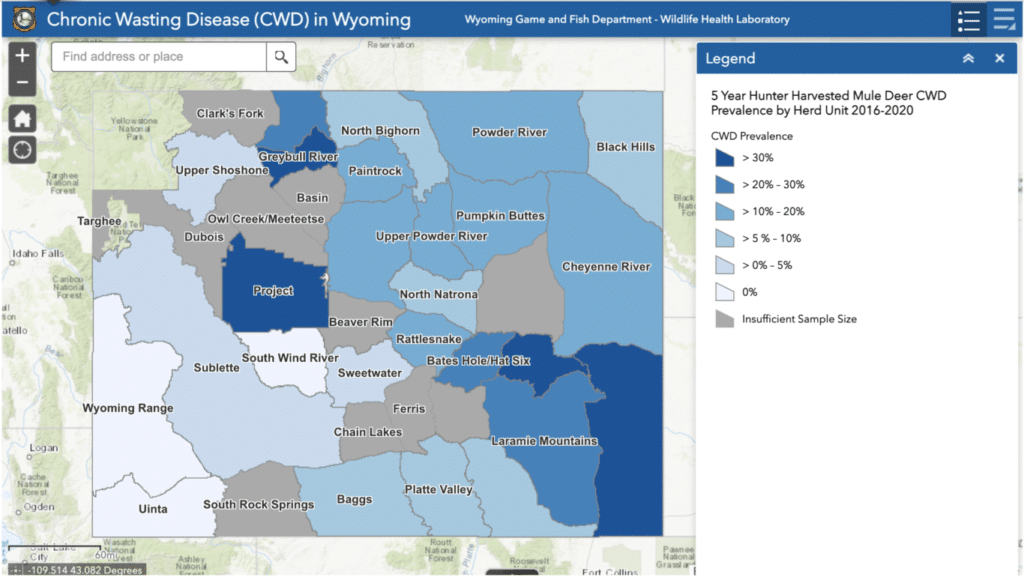Editor’s Note: Updated March 18, 2022
Chronic wasting disease (CWD) has been a chronic worry for Wyoming’s mule herds, causing slow wasting and death in any infected animals for 35 known-years. During the early years of managing this disease, Wyoming chose a cautious wait-and-see approach to managing the disease. Given the unknowns about CWD at the time, that was as reasonable a decision as any. There has been a significant amount of research on the disease in Wyoming, in neighboring Colorado, and in states like Wisconsin. The research thus far has shown us that CWD has negative effects on deer populations at infection rates above 10%.
Recent data shows many of Wyoming’s herd-units are at these upper levels of CWD prevalence and are experiencing population-level impacts. For game managers, this means that the wait-and-see approach is no longer an option to maintain healthy mule deer populations. Wyoming Wildlife Federation, as well as other partners in conservation, are working to get the word out and help the Wyoming Game and Fish Department (WGFD) move the needle on managing this disease. Many believe we (as a state) waited longer than we should have to take action in reducing CWD prevalence, but it’s not too late to do right by our herds.

WWF had a seat on the working group advising WGFD as they created a proposed CWD management plan. The working group brought together individuals from management agencies, nonprofits, the outdoor industry, and state leadership to discuss options and reach consensus as much as possible on a management approach. While the WGFD created a management plan based on these recommendations of the working group, the management plan needs to be adopted by the Wyoming Game and Fish Commission before being enacted.
The Federation supports two management actions specifically to help reduce CWD prevalence: the reduction in population density, especially older age males, in high prevalence areas, and the careful disposal of carcasses, as these management techniques are most supported by the available evidence.
“As the overall rate of infection in a herd increases, mule deer are infected & succumb at younger ages. Older aged deer become rare.” Chronic Wasting Disease in Colorado:
Past, Present, & Future. Provided by Colorado Parks and Wildlife
One of the first hurdles to effective disease management is knowing what wildlife is facing. To fill in gaps of data, the WGFD has set up CWD testing priority hunt areas for deer and elk that shift every year. The rolling testing allows WGFD to get a good idea of prevalence across the state while not exceeding the state’s testing capacity. Under this plan, all hunt areas across the state will be intensively tested every five years. In the 2019 season alone, WWF distributed sample collection kits, trained folks on sample collection, and collected 300 tests in the Sheridan target units, contributing half of WGFD’s testing goal. In the coming year, it’s crucial for WGFD in collecting enough tests to give us a complete picture of this disease, and WWF encourages everyone to help be part of the solution. If you have a moment and will be harvesting potential CWD-carrying ungulates in 2020, be sure to watch this lymph node removal video so you can contribute to sample size collection, as well!
In the last year, WWF held an informational talk in Lander to help spread the word on why this new take on CWD is necessary and what it means, good and bad, for hunters and our mule deer populations. While the current COVID-19 situation has made organization efforts tricky in 2020, it’s vital for hunters, as well as the general public to understand the best information that game managers have available in response to this disease.
CWD is and will remain a sticky problem without a perfect solution, but there are things that we can do to slow the spread and reduce prevalence to help protect the future of our deer and elk herds.
Read the Hunting Pressure & CWD Rates Study Published Oct. 2020:
CWD Hunting Miller et al. 2020 FINAL
Andrea Barbknecht is the WWF education director, as well as our staff biologist. Since 2018, she has been working diligently on WWF’s Chronic Wasting Disease education and testing program to help better inform people in Wyoming about the disease.
